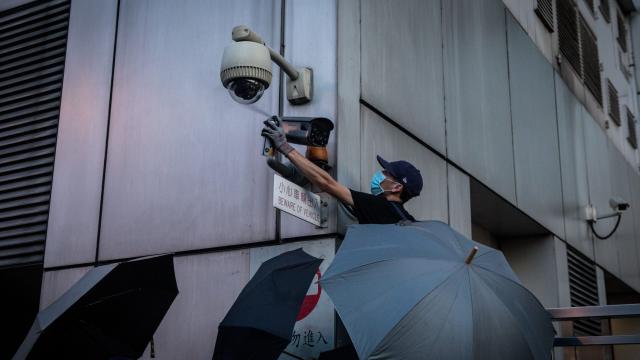Simply moving through the physical world in regions with massive, powerful surveillance systems threatens to strip one of their anonymity, and in places with anti-government demonstrations, that threat is disturbingly amplified. But protesters in Hong Kong are countering these gross invasions of privacy.
In Hong Kong, hundreds of thousands of civilians are estimated to have filled the streets in June to protest a bill that would allow the government to extradite suspected criminals to mainland China, a violation of their democratic freedom.
Anti-extradition demonstrations have been ongoing for weeks in Hong Kong, and police are turning to increasingly aggressive and violent means to quash the efforts. In response, protesters created their own channel to identify plainclothes cops.
The channel, called Dadfindboy, was created on cloud-based messaging app Telegram and has over 50,000 subscribers, according to a report published this week by The New York Times.
The channel was largely created in response to cops no longer wearing their identification badges, and reportedly doxxed officers with posts including their personal information, social media posts, and both intimate photos and photos of their family.
The channel also included tips on how to shoot a slingshot, how to make a blow torch, and surveyed users on the best way to handle police, with the options prison, gas chamber, live burial, guillotine and machine-gun execution, according to The New York Times. There’s reportedly no evidence suggesting that this forum prompted any violent acts, however.
The New York Times report also illustrated how protesters fought back against surveillance devices. During a demonstration on Sunday, some of them reportedly aimed laser pointers at cameras and spray painted surveillance cameras outside of the government liaison office.
A protester detailed in the report, Colin Cheung, also began to develop a tool to deal with corrupt plainclothes cops, but ultimately ceased efforts because he didn’t have the time. The concept for the tool, though, is an ironic display of how surveillance tools can be used to counter each other.
Cheung had started creating a facial recognition tool that used an algorithm to match photos that had been posted on the internet with photos of police officers in an attempt to identify those who no longer identified themselves.
It’s hardly surprising that protesters would turn around and use the very tools weaponized against them to protect their own identities while outing those who are engaging in apparent misconduct. But vandalising a few cameras and launching a thriving online social forum does not constitute a solution to pervasive privacy violations in the region.
Protesters have more to fear than just cameras and unidentifiable cops — there even exists distrust in using one’s credit cards or getting treated at an emergency room at the risk of being tracked down by the cops.
“The moment you are protesting against your government, a seamless public transit system can turn into a rich source of data for surveillance and crowd control,” Frederike Kaltheuner, who leads Privacy International’s work on corporate surveillance, wrote in an essay for Gizmodo.
And so protesters are getting creative, turning weapons of mass surveillance against the system that is going to great lengths to strip them of their privilege to anonymity and pressure them into submission.
